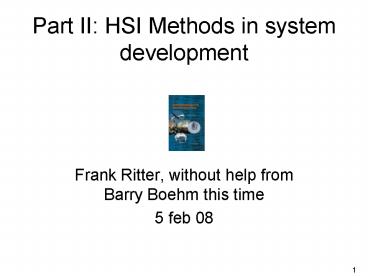Part II: HSI Methods in system development
1 / 27
Title:
Part II: HSI Methods in system development
Description:
Assumes a stakeholder analysis (e.g., business offer, ... Field Observations and Ethnomethodology. Both holistic, and solely descriptive and generalizable ... –
Number of Views:37
Avg rating:3.0/5.0
Title: Part II: HSI Methods in system development
1
Part II HSI Methods in system development
- Frank Ritter, without help from Barry Boehm this
time - 5 feb 08
2
Glossary
- EDA Event Data Analysis
- FMEA Failure modes and effects analyses
- SA Situation Awareness
- WoO Wizard of Oz
- WoO2 WoO squared
3
The Incremental Commitment Life Cycle Process
Overview
Stage I Definition
Stage II Development and Operations
Anchor Point Milestones
Synchronize, stabilize concurrency via FRs
Risk patterns determine life cycle process
4
The Risk Management Process
- Good practices for program management
- Assumes a stakeholder analysis (e.g., business
offer, proposal, specification) - Including HSI in this process
- A program organization
- Culture of openness
5
The Risk Management Process Handling Options
- Comments
- Dealing with large risks
- HSI has a set of tools for these options, more
for avoid (know user and task), Assume (monitor),
Mitigate (understand, modify) - Ritters impression is that in normal progress,
risk sizes decrease over time
6
Methods
- Three major periods of use
- Define context of use
- Define requirements and design solutions
- Evaluate
- All fit back into spiral, all used to reduce
risks using previous approaches - We have bags of these methods!
- Classification to period is somewhat arbitrary
- Not exhaustive, illlustrative
- Function allocation not covered
- Performance measurement details not covered
7
Some Assumptions of the Report
- Technology advanced enough to support users
- Risks shifting to user interaction and not
technology - Environments are changing, so designing based on
old assumptions more risky than previously
8
Area 1 Context of Use
- Helps avoid local optimizations, feature creep,
unanticipated effects
9
Organizational and Environmental Context
- Overview
- Shared representations
- Use
- Contributions
- Strengths, limitations, and gaps
10
Notes on context of use
- Gaps of perception
- So communication and perception count
- Communication interfaces need to be developed
- A problem remains How big is a context? Where
does it stop?
11
Field Observations and Ethnomethodology
- Both holistic, and solely descriptive and
generalizable - Helps system designers understand the context of
use, perhaps for the first time - Hallmark is its ability to change focus and
direction when faced with new insights - Privileges users as a stakeholders
- But needs to change to teach system designers -
Ritter - To have more impact and to be fair, needs to
similarly privilege users of information -
designers - Ritter
12
Task Analysis
- Can reuse previous methodology
- Focuses on the shared representation
- May be seen as that - Ritter
- Seen as too hard by some designers (?)
- Can be done in a grounded way
- Can draw on many other methodologies
- Can be reused in many places
- Is not always reused at all
- Insight Impact on next project
- Size of users tasks, complexity of tasks, their
interrelation, scope - May be true for all these methods
- So shared to next design, and understanding of
designer
13
Participatory Analysis
- Insight Can be combined with many other methods
- Getting users involved in the process
- Communication can be difficult, but rewarding
- Push back from designers is not understanding
their risks as designer and implementers - Ritter
14
Event Data Analysis
- All kinds of data
- Looking for patterns
- Relies on shared representations
15
(No Transcript)
16
(No Transcript)
17
EDA notes
- Plenty of resources, tools, methods
- Ties to TA, other approaches
- Selection of data analyses
- Problems
- Can focus on wrong measures
- Will always work
- Requires prototype
18
Area 2 Defining Requirements and Design
19
Stretch of these tools
20
Usability requirements
- Usability is not likability (seen in Rossen and
Carroll chapter) - Hard to know if systems will meet these measures
- Dont have good measures and standards
- Optimizes what is measured
21
Situation Awareness
- Does the mental model match the world?
- Useful for system designers to keep in mind!
22
Personas
- Designed to be a shared representation of users
- Role or segment archeotypes
- Particularly when designers are not like the
users - See Ritter, Freed, Hasket for a weak example
23
Models
- Risk we are not like we think we are
- Running models in our head is hard
- But models hard to use
- But but working on models to be more usable
- Insight perhaps especially here, designers learn
for the next design
24
Area 3 Methods for Evaluation
- Also see all previousmethods
25
Failure modes and effects analyses (FMEA)
- Identify risks, etc.
- Recursive of risk analysis to end user use
- Tools make easier (and perhaps more fun, and
perhaps sharable)
26
Types of Human Errors
27
Usability Analysis
- End of the road, small risks
- Uses performance measures, experimental design,
psychology, physiology, ergonomic sciences































